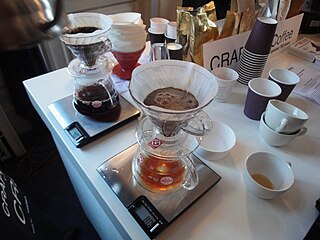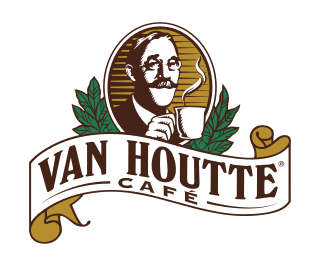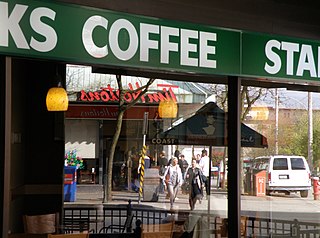
Drip coffee is made by pouring hot water onto ground coffee beans, allowing it to brew. There are several methods for doing this, including using a filter. Terms used for the resulting coffee often reflect the method used, such as drip-brewed coffee, or, somewhat inaccurately, filtered coffee in general. Manually brewed drip coffee is typically referred to as pour-over coffee. Water seeps through the ground coffee, absorbing its constituent chemical compounds, and then passes through a filter. The used coffee grounds are retained in the filter, while the brewed coffee is collected in a vessel such as a carafe or pot.

Tully's Coffee is an American specialty coffee manufacturing brand owned by Keurig Dr Pepper, which acquired Tully's brand and wholesale business in 2009.

Hires Root Beer was an American brand of root beer that was manufactured by Keurig Dr Pepper. Introduced in 1876, it was one of the longest continuously made soft drinks in the United States.
Flavia is a hot beverage system that prepares single servings of coffee, tea, and hot chocolate drinks. The brand was owned by Mars Drinks, a division of Mars, Incorporated until October 1, 2018, when Lavazza purchased Mars’s coffee units.

Timothy's World Coffee is a large Canadian coffee roasting company and chain of coffeeshops.

International Coffee & Tea, LLC, doing business as The Coffee Bean & Tea Leaf, is an American coffee shop chain founded in 1963. Since 2019, it is a trade name of Ireland-based Super Magnificent Coffee Company Ireland Limited. Its 80% stake is by multinational company Jollibee Foods Corporation. It operates as an independent subsidiary and remains headquartered in Los Angeles, California.
Bunn-O-Matic Corporation is an American manufacturer of dispensed beverage equipment headquartered in Springfield, Illinois, with a plant in Creston, Iowa. The company was founded in 1957 by George R. Bunn, who designed his own versions of equipment that had been in existence for nearly fifty years: paper coffee filters and pour-over drip coffee brewers. Today, the corporation's products are sold under the BUNN and Bunn-O-Matic brands. The company's home coffeemakers are used throughout the United States and Canada, but the company's primary customers are institutional foodservice providers worldwide. The company introduced their first automatic drip-brew coffee maker in 1963. The company introduced their first drip brewer for the home market in 1972. The current president and CEO is Arthur H. Bunn.

The Tassimo Hot Beverage System is a consumer single-serve coffee system that prepares one-cup servings of espresso, regular coffee, tea, hot chocolate and various other coffee drinks, notably those including milk such as latte or cappuccino. The brand is owned by JDE Peet's in most of the world and Kraft Heinz in North America.

Van Houtte Inc. is a company based in Montreal, Quebec, Canada that processes, distributes and sells coffee and coffee related goods. They have expanded their product selection, which now includes tropical teas, sandwiches and salads. It was founded by Albert-Louis Van Houtte.
Keurig Dr Pepper Inc., formerly Green Mountain Coffee Roasters (1981–2014) and Keurig Green Mountain (2014–2018), is a publicly traded American beverage and coffeemaker conglomerate with headquarters in Burlington, Massachusetts and Frisco, Texas. Formed in July 2018, with the merger of Keurig Green Mountain and Dr Pepper Snapple Group, Keurig Dr Pepper offers over 125 hot and cold beverages. The company's Canadian business unit subsidiary operates as Keurig Dr Pepper Canada.

A single-serve coffee container is a container filled with coffee grounds, used in coffee brewing to prepare only enough coffee for a single portion. They come in various formats and materials, often either as hard and soft pods or pads made of filter paper, or hard aluminium and plastic capsules.
Emilio Lavazza (1932–2010) was an Italian businessman. Known as, "Mr. Espresso," he shaped the way many Italians drink their coffee and dedicated half of his lifetime to provide quality coffee globally. Lavazza served as the Chief and President of the Lavazza company. He served as President of Lavazza from 1979 until 2008.Throughout his lifetime, he had received much recognition such as, Honorary President prior to retiring his position in the Lavazza company. In 2010, Lavazza died due to a severe heart attack in Turin, Italy. The Lavazza company, today, is the sixth biggest coffee roaster with mustering over $1.1billion euros in sales. The company sells coffee in more than 90 countries after Emilio's reign as head of Lavazza.
Lambertus Johannes Hermanus "Bart" Becht is a Dutch businessman. An executive with more than 35 years of business experience working with consumer brands, Becht is the former Chief Executive Officer of Reckitt, which he led from 1995 to 2011 and former Partner at JAB Holding Company, which he joined in 2012. Becht announced his retirement from JAB in 2019.

The Easy Serving Espresso pod, is a small packed coffee pod with a paper filter covering for use in a non-grinding espresso machine. The E.S.E. standard was created by Italian Illy in the 1970s and is maintained by the "Consortium for the Development and the Protection of the E.S.E. Standard." It is open to all coffee roasters and machine manufacturers, making it the self-acclaimed "only open system available to the sector for espresso coffee prepared with paper pods".

Coffee wars, sometimes referred to as caffeine wars, involve a variety of sales and marketing tactics by coffeehouse chains and espresso machine manufacturers to increase brand and consumer market share. In North America belligerents in these wars typically include large coffeehouses, such as Starbucks, Dunkin', McDonald's, and Tim Hortons. According to The Economist, the largest coffee war of the late 2000s was between Starbucks and McDonalds in the United States. The U.S. market has, since the early 2010s, been primarily contested by its two largest players, Starbucks and Dunkin'. Since 2020, competition over the Chinese coffee market has intensified between Starbucks and Luckin Coffee.
JAB Holding Company is a German conglomerate, headquartered in Luxembourg, that includes investments in companies operating in the areas of consumer goods, coffee, luxury fashion, animal health, and fast food, among others.

Nestlé Nespresso S.A., trading as Nespresso, is an operating unit of the Nestlé Group, based in Lausanne, Switzerland. Nespresso machines brew espresso and coffee from coffee capsules, a type of pre-apportioned single-use container, or reusable capsules (pods), of ground coffee beans, sometimes with added flavorings. Once inserted into a machine, the capsules are pierced and processed, water is then forced against a heating element at high pressure meaning that only the quantity for a single cup is warmed. By 2011 Nespresso had annual sales in excess of 3 billion Swiss francs. The word Nespresso is a portmanteau of "Nestlé" and "Espresso", a common mechanic used across other Nestlé brands.
La Colombe Coffee Roasters is an American coffee roaster and retailer headquartered in Philadelphia. The company was founded in 1994 and has cafés in locations including Philadelphia, New York, Chicago, Boston, and Washington D.C. In 2023, it was acquired by Chobani for $900 million.

Spinn Inc. is a San Francisco-based coffee-subscription business. The coffee makers from Spinn, are said to be Wi‑Fi–connected and app-controlled, and thus, these are said to demand minimal effort from the users.
Robert J. (Bob) Gamgort is an American businessman who is the Chairman and CEO of Keurig Dr Pepper, the seventh largest food and beverage company in the United States. Gamgort became President and CEO in July 2018, upon the completion of the merger between Keurig Green Mountain and Dr Pepper Snapple Group, and added the responsibility of Chairman in January 2019.













